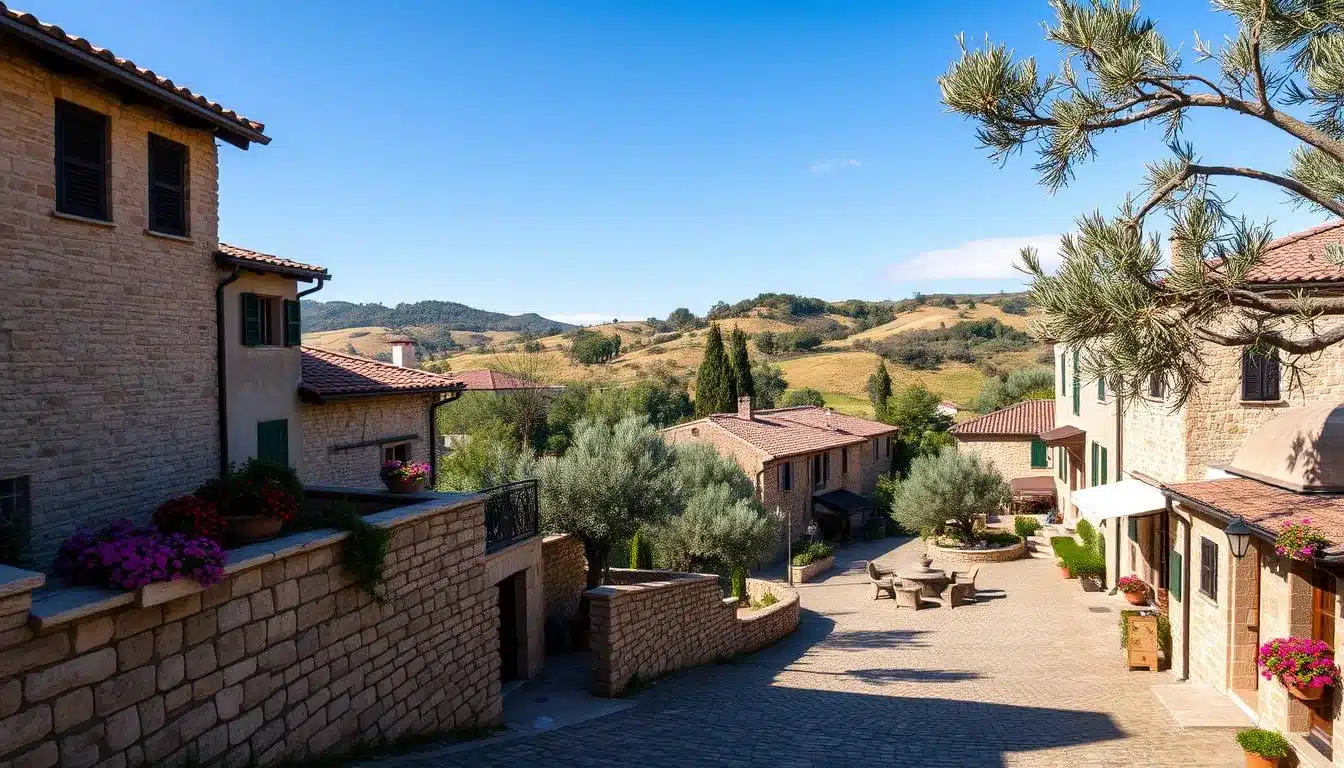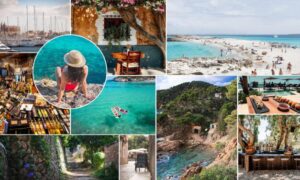What if Italy’s true magic is found in its quiet villages, not big cities? Places like Manarola and Portofino are hidden gems. They offer stunning views and a slower pace of life.
These villages are more than just pretty pictures. They are a chance to experience Italy’s true beauty. Traveling here means discovering a world where time stands still and beauty is everywhere.
Key Takeaways
- Italy’s villages blend natural beauty with centuries of culture.
- Coastal gems like Manarola and Portofino feature vibrant architecture.
- Many villages remain uncrowded compared to major cities.
- Each destination offers unique local traditions and cuisine.
- Travel Italy to discover hidden trails, historic sites, and lakeside retreats.
Italy’s villages are a mix of fishing towns and medieval hamlets. They are waiting for you to explore. Are you ready to find places where time moves slower and beauty is all around?
Discovering Italy’s Most Beautiful Hidden Villages
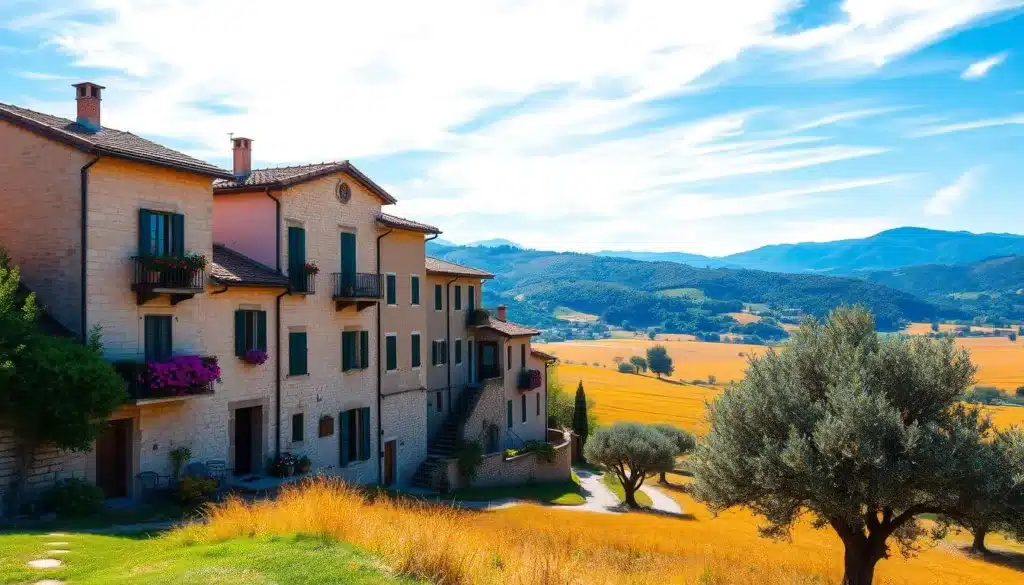
Italy’s scenic villages are like pages from a storybook. They are nestled between vineyards, olive groves, and rugged coastlines. These spots offer a peek into traditions that have stood the test of time.
Cobblestone streets lead to sunlit piazzas where locals enjoy espresso and chat. Every corner is filled with history, art, and warmth.
The Charm of Italian Village Life
Life here moves at its own pace. Farmers work on old vineyards, artisans make pottery by hand, and trattorias serve family recipes. Villages like Civita di Bagnoregio or Castelmezzano sit on cliffsides, blending with the landscape.
This is where Italy’s soul thrives—a mix of simplicity and beauty.
Why These Villages Should Be On Your Bucket List
- Authentic cultural experiences, from harvest festivals to artisan workshops.
- Stunning landscapes, including terraced hills and coastal vistas.
- Fewer crowds compared to major cities like Rome or Florence.
Best Times to Visit Italian Villages
Choosing the right time to visit is key. Spring and autumn offer mild weather for exploring. Summer festivals bring music and food, while winter is cozy with fewer tourists.
| Season | Weather | Activities |
|---|---|---|
| Spring | Mild, 60-75°F | Wildflower hikes, Easter processions |
| Summer | Warm, 70-90°F | Festivals, beach visits |
| Autumn | Cool, 50-70°F | Wine harvests, truffle hunting |
| Winter | Chilly, 30-50°F | Christmas markets, snow-capped views |
Coastal Treasures: Manarola and Portofino
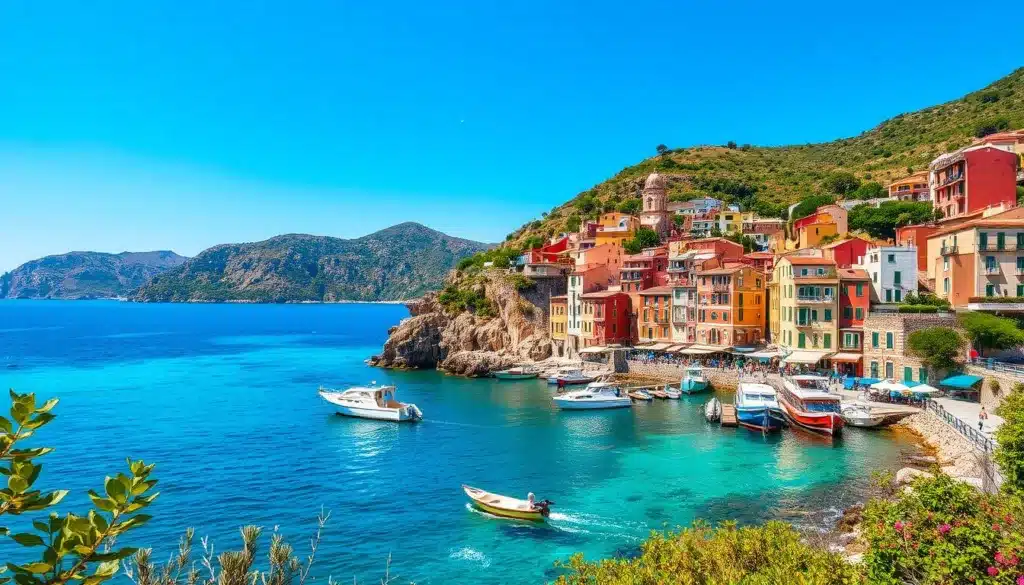
The Italian coast is full of treasures, but Manarola and Portofino stand out. These towns show Italy’s beauty, from rugged cliffs to elegant shores.
Manarola is a UNESCO World Heritage site in Cinque Terre. It’s famous for its colorful houses on steep terraces. The village’s vineyards and olive groves lead to the sea, making perfect views.
Walking through Manarola’s alleys, you’ll find family-run trattorias. They serve delicious pesto pasta. The Sentiero Azzurro trail offers stunning sea views.
“Watching the sunset paint Manarola’s cliffs in gold hues feels like stepping into a living painting.”
Portofino is a different world. Its harbor is a haven for yachts and fashion lovers. You can shop in designer boutiques and enjoy a drink at Café Martini.
Don’t miss the hike to Castello Brown. It offers amazing views of the Riviera di Levante.
- Manarola Highlights: Nighttime Nativity light display (December), Via dell’Amore cliff path, Sciacchetrà wine tasting
- Portofino Must-Dos: Parco Naturale Regionale hikes, Chiesa di San Giorgio relics, waterfront seafood at Ristorante Puny
| Feature | Manarola | Portofino |
|---|---|---|
| Best For | Hikers, photographers | Luxury seekers, sailors |
| Signature Dish | Anchovies with lemon | Trofie al pesto |
| Peak Season | April-October | May-September |
Manarola and Portofino share the Mediterranean’s beauty but are different. Manarola is rustic, while Portofino is glamorous. Together, they show the Italian coast’s charm.
The Spectacular Amalfi Coast: Exploring Positano
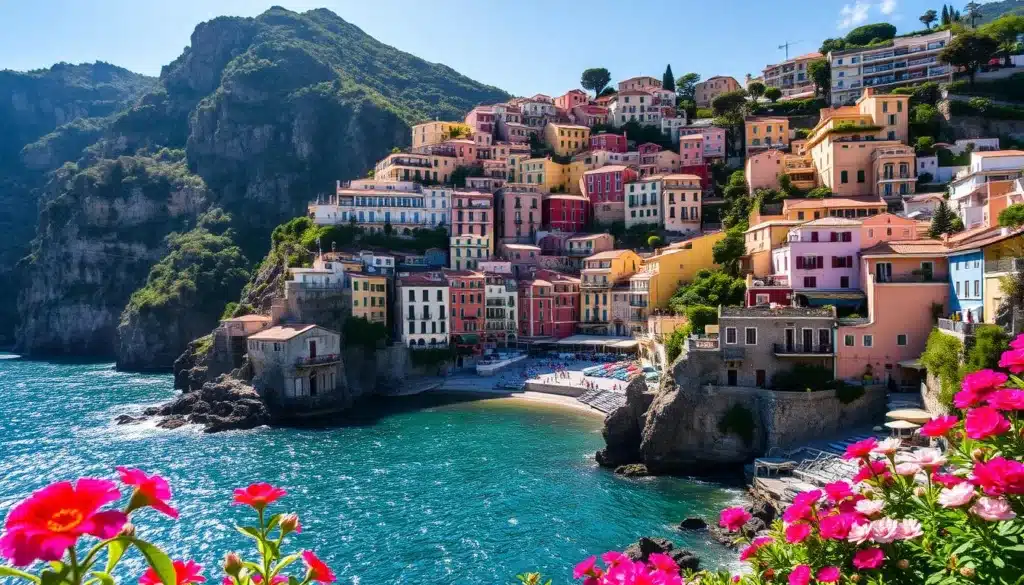
The Amalfi Coast in southern Italy is a true marvel. Positano, its highlight, is famous for its colorful houses and blue waters. The town’s narrow streets, filled with flowers and shops, are perfect for walks or enjoying seafood by the sea.
Getting to Positano
Getting to Positano is worth the effort for its stunning views. You can:
- By car: Drive from Naples or Sorrento for cliffside views. But, parking is hard, so get there early.
- By bus: SITA buses from Sorrento pass through villages like Praiano.
- By ferry: Ferries run to Capri, Salerno, and other Amalfi Coast towns.
Best Viewpoints in Positano
Here are the best places to see Positano:
- Spiaggia Grande: The main beach offers a view of villas against the sea.
- Chiesa di Santa Maria Assunta: The church’s dome is a great photo spot from the pier.
- Path of the Gods: This trail gives you amazing views of the Amalfi Coast.
“Watching the sunset from my hotel terrace, with Positano glowing below, felt like stepping into a painting.” – Traveler’s Journal
Where to Stay in Positano
Positano has many places to stay, from fancy hotels to cozy guesthouses:
- Le Sirenuse: A luxury hotel with terraces over the bay.
- Hotel Marincanto: A mid-range hotel with private balconies and pools.
- Boutique B&Bs: Family-run places like Casa Albertina offer charm and good prices.
Staying in Positano means waking up to the Amalfi Coast’s beauty every morning.
Ancient Stone Wonders: Matera and Castelmezzano
Matera and Castelmezzano are nestled in the Italian hills. They are iconic hilltop villages where history and nature meet. These places show Italy’s ancient past and have landscapes that seem almost magical.
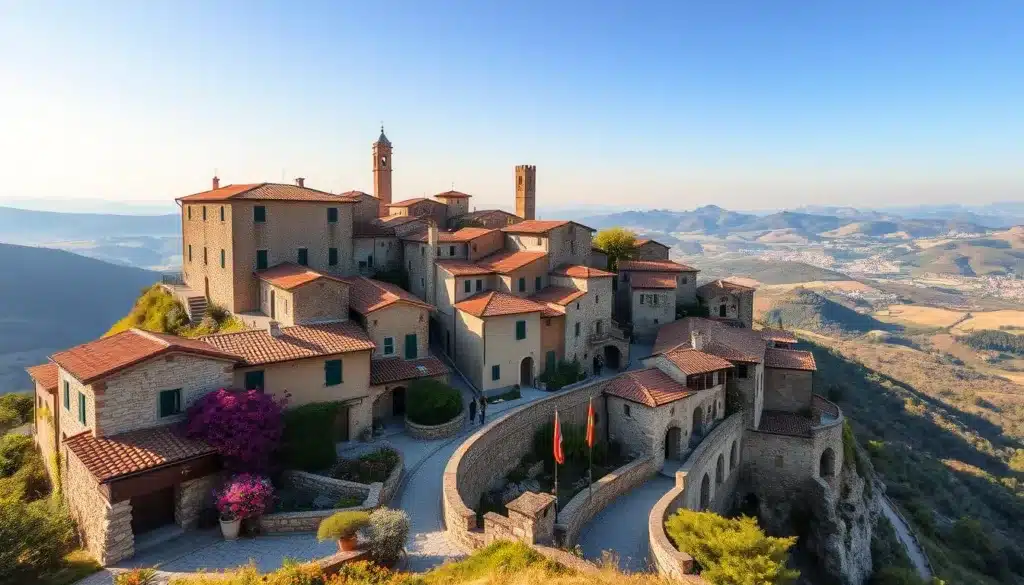
Matera’s Sassi di Matera is a UNESCO site known for its beauty. It has stone homes and churches carved into the rock. Walking through its narrow alleys, you see cave dwellings from 9,000 years ago.
From Piazza San Pietro, you get stunning views of the Gravina ravine. This spot is loved by photographers and history buffs.
“Walking through Matera feels like stepping into a story carved by time itself. Every stone whispers secrets of survival and creativity.”
Castelmezzano sits high in the Dolomiti Lucane mountains, offering a peaceful charm. Its terracotta roofs seem to defy gravity, set against jagged peaks. It’s a haven for adventure, with the Volo dell’Angelo zipline and the Path of the Seven Stones for hikers.
Both villages show the beauty of the Italian hills. They mix nature’s power with human determination. Whether you explore Matera’s underground or enjoy Castelmezzano’s honey, these places invite you to slow down and enjoy Italy’s wild side.
The Cinque Terre Experience: Vernazza’s Timeless Beauty
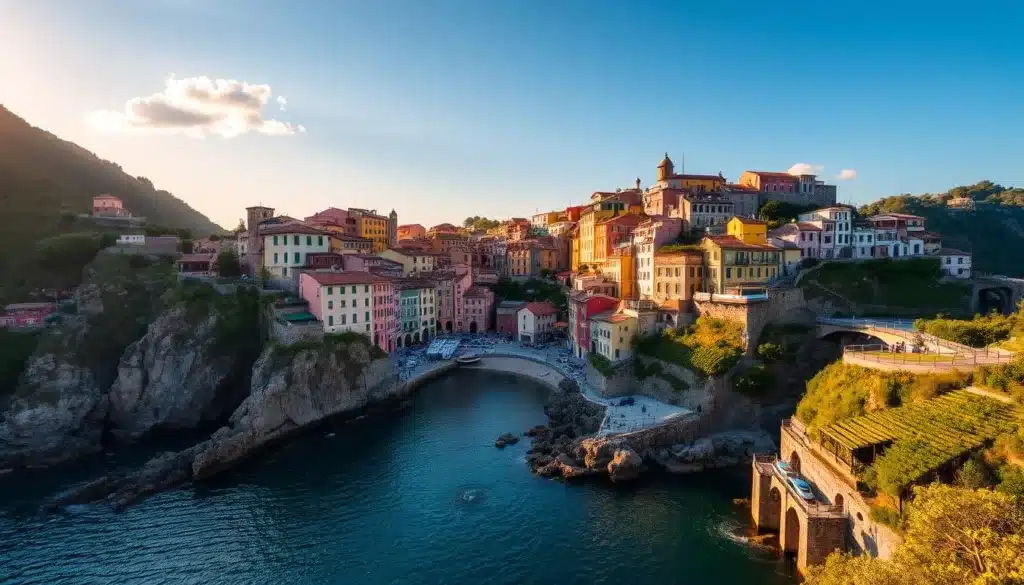
Vernazza is a gem in the Cinque Terre, known for its colorful homes on steep cliffs. The sound of waves hitting the harbor is soothing. Narrow streets lead to family restaurants and shops.
This village shows the true spirit of the Italian Riviera. It’s a place where time moves slowly, yet it’s full of life. It’s rich in sea traditions.
Hiking Trails Around Vernazza
Vernazza is a starting point for Cinque Terre’s famous trails. The most loved paths are:
- Sentiero Azzurro (Blue Trail): A 90-minute coastal hike to Monterosso, offering panoramic sea vistas
- Vernazza-Corniglia Path: A quieter 45-minute walk through vineyards and olive groves
- High Country Route: Challenging 3-hour climb to ancient watchtowers with valley views
| Trail | Difficulty | Highlights |
|---|---|---|
| Blue Trail | Moderate | Cliffside vistas, lemon orchards |
| Corniglia Path | Easy | Vineyard terraces, wildflowers |
| High Country | Strenuous | 360° panoramas, medieval ruins |
Local Cuisine and Dining
Vernazza’s food scene is all about Ligurian tastes. At Ristorante Belforte, try trofie al pesto with basil from Pra’. Fresh anchovies are a must at Gianni Franzi.
“Our recipes carry the salt of these cliffs and the sweetness of the sea breeze—every bite tells Vernazza’s story.”
Don’t miss the focaccia di Recco at Il Fornaio bakery. It’s a cheese-filled flatbread best warm. Enjoy it with Sciacchetrà, a golden dessert wine.
Lake Como’s Finest: Bellagio and Varenna
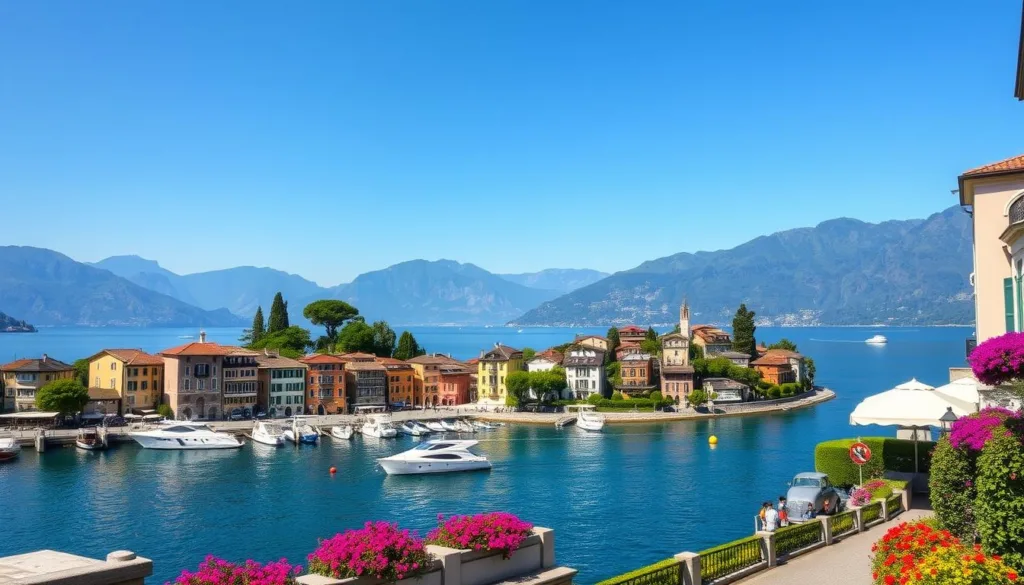
The towns of Bellagio and Varenna sit on Italy’s famous Lake Como. They are known for their beauty and charm. The mountains and water make a perfect scene for these villages, attracting those who want to relax and explore.
Bellagio is called the “Pearl of Lake Como,” with its cobblestone streets and big villas. You can walk by the lake and see beautiful gardens or visit old places like Villa Melzi. The town has many shops and cafes by the water, perfect for a slow day. For amazing views, try the Serbelloni Path, where you can see the lake and olive groves.
- Varenna’s quieter charm comes from its colorful houses and secret spots.
- See the 12th-century Castello di Vezio for stunning views of the lake.
- Explore Villa Monastero’s gardens, filled with exotic plants.
“Lake Como’s magic isn’t just in its views—it’s in the rhythm of life by the water.”
| Feature | Bellagio | Varenna |
|---|---|---|
| Highlights | Villa Melzi, Serbelloni Path | Castello di Vezio, Villa Monastero |
| Vibe | Bustling, elegant | Tranquil, intimate |
| Best Activity | Lakeside dining | Sunset ferry rides |
Ferries link Bellagio and Varenna, making it simple to see both in one day. Enjoying risotto alla Milanese in Bellagio or coffee on Varenna’s dock, Lake Como leaves a lasting memory of Italian calm.
Islands and Coastal Gems: Discovering Corricella
Corricella is a gem on Procida Island, showing the true spirit of Italian island life. This lively fishing village, hidden among the lesser-known Italian islands near Naples, boasts colorful houses and a rhythm set by the sea and traditions. It’s a place where quiet charm meets vibrant culture, ideal for those seeking real experiences.
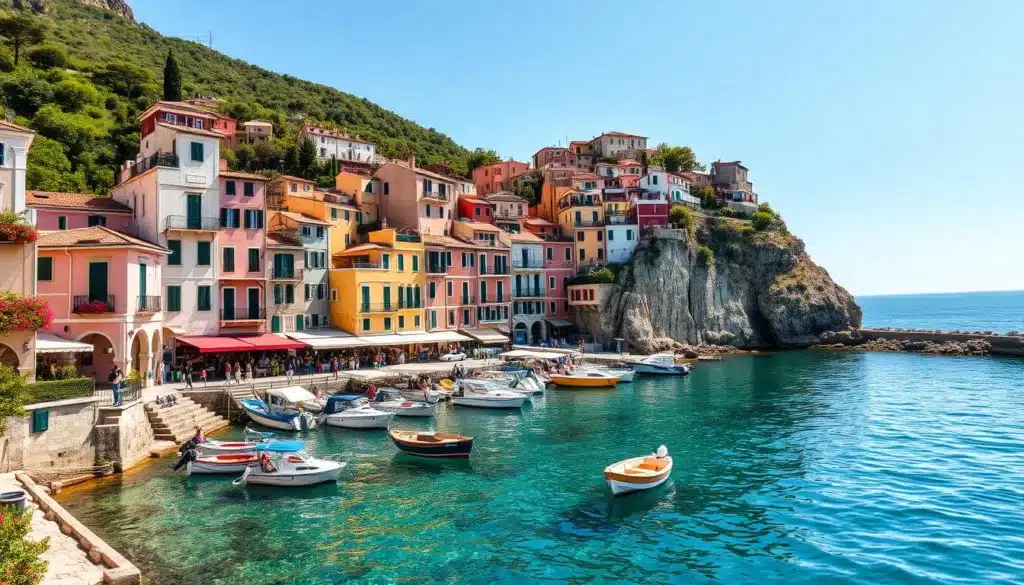
Getting to Corricella
To get to Corricella, take a ferry from Naples or Ischia. The trip is under an hour, offering stunning views of the Tyrrhenian Sea. Since Procida is small, you won’t need a car. Just walk or rent a scooter to explore the narrow streets.
Best Photo Spots
- The harbor at sunrise, when fishing boats return with their catch
- Via Salita Castello for panoramic views of the village
- The pastel facades along Via Roma, glowing in midday light
Local Experiences
Experience dawn with fishermen learning net-mending. Try linguine alle vongole at family-run trattorias. Or, explore secret coves by boat. Don’t miss Procida’s La Sagra del Mare festival in July, celebrating the sea.
“Corricella isn’t just a place—it’s a feeling. The colors, the sea, the laughter echoing off the walls… it stays with you.”
Walking through sunlit squares or enjoying espresso by the dock, Corricella invites you to slow down. Its magic is in the moments, not the monuments. It reminds us that island life is best savored, not rushed.
Tuscany’s Medieval Marvel: San Gimignano
San Gimignano sits in Tuscany’s hills, a medieval gem. Its skyline is marked by 14 towers, telling stories of old rivalries. This UNESCO site keeps its old charm alive, unlike many Italian towns.
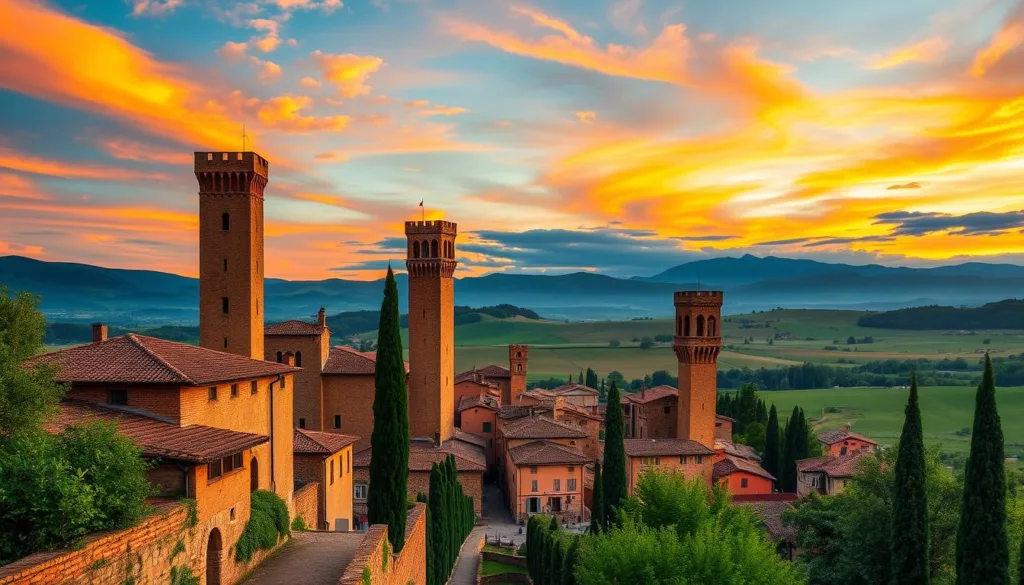
The towers were once symbols of power for feuding families. Climbing Torre Grossa offers views of vineyards and olive groves. Down below, narrow streets lead to shops selling saffron and Vernaccia wine, a local favorite since the Renaissance.
“Walking through San Gimignano feels like stepping into a fresco. Every corner reveals a story.”
Don’t miss these spots:
- Piazza della Cisterna: A square with medieval wells and gelato shops.
- Collegiate Church of San Gimignano: Home to detailed biblical frescoes.
- Rocca di Montestaffoli: A fortress perfect for sunset photos.
Food enthusiasts will love the wild boar stew and pici pasta. Enjoy them with a glass of golden Vernaccia, praised by Dante. Visit in spring or fall for fewer crowds and pleasant weather.
San Gimignano’s charm comes from its mix of history and culture. It invites visitors to dive into Italy’s medieval past, from admiring frescoes to trying saffron gelato.
Hidden Treasures: Orvieto and Castellucio
Italy is full of hidden wonders that leave a lasting impression. Orvieto and Castellucio are two such places. They offer a mix of history, culture, and natural beauty. These spots let travelers explore paths less traveled and dive into a world rich in tradition.
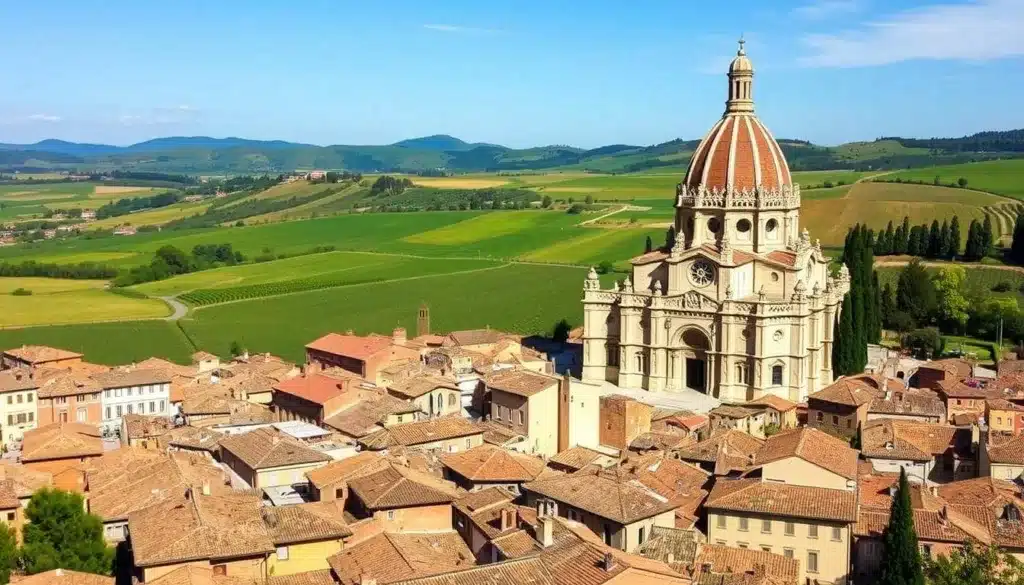
Orvieto’s Underground City
Orvieto’s underground is a testament to ancient engineering. It was carved into volcanic rock over 2,500 years ago. This network includes tunnels, wells, and chambers for storage, olive pressing, and refuge.
Visitors can take guided tours to see places like Pozzo della Cava, a 36-meter-deep Etruscan well. “Walking through Orvieto’s underground feels like uncovering a secret world,” a local guide notes. The town’s iconic Duomo, with its striking mosaic facade, adds to its charm.
Castellucio’s Natural Spectacles
Castellucio is a gem in the Sibillini Mountains. Every spring, the Piano Grande plateau turns into a colorful canvas. The Fioritura bloom brings a kaleidoscope of wildflowers.
Hikers and photographers come for the stunning views of red poppies, yellow rapeseed, and purple lentils. In winter, the valley offers a peaceful snowscape for cross-country skiing. The Festa della Fioritura in July celebrates the region’s farming traditions with food and music.
| Feature | Orvieto | Castellucio |
|---|---|---|
| Best Season | Year-round | Spring/Summer |
| Top Attraction | Underground tunnels | Piano Grande bloom |
| Local Specialty | Orvieto Classico wine | Lentils of Castellucio |
Jewish Heritage and History: Exploring Pitigliano
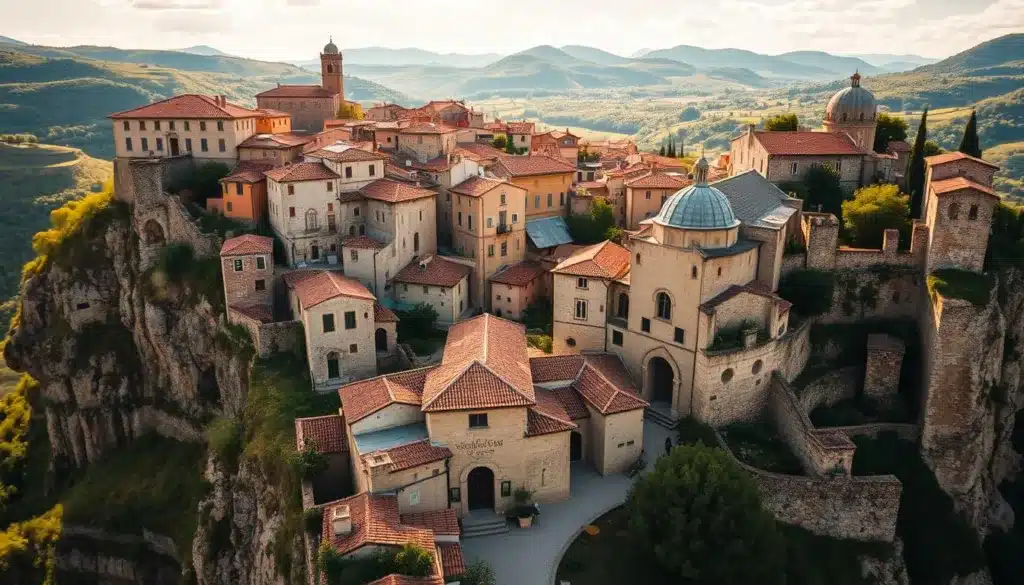
Pitigliano sits on a dramatic tufa cliff in southern Tuscany. It has winding streets and a rich Jewish heritage. Known as “La Piccola Gerusalemme” (Little Jerusalem), it has kept its Jewish ties since the 16th century.
The Jewish community here thrived for centuries. They left a mark on the village’s architecture, cuisine, and stories. This mix of traditions is still seen today.
The synagogue in Pitigliano is a key part of its Jewish heritage. Built in 1598, it has been beautifully restored. The Jewish Quarter has ancient bakeries, a ritual bath (mikveh), and a museum. A local saying goes:
“In Pitigliano, even the stones whisper history.”
Travelers can enjoy several experiences in Pitigliano:
- Walking the Via Zuccarelli, lined with artisan shops and historic homes.
- Tasting sfratto, a honey-walnut pastry tied to Jewish-Etruscan traditions.
- Exploring the underground network of cellars used for wine and olive oil storage.
Pitigliano’s Jewish heritage is alive today. Festivals celebrate shared customs, and guided tours highlight the community’s resilience. The village’s golden stone buildings shine at sunset, creating a timeless scene.
Whether you wander its alleys or try kosher-inspired dishes, Pitigliano offers a unique history. It invites travelers to explore layers of history rarely found in Italy.
The Floating City: Civita di Bagnoregio
Civita di Bagnoregio sits on a crumbling plateau in Italy’s Lazio region. It looks like it’s floating above the clouds. This medieval village is a mix of history and natural beauty.
Its location, only reachable by a narrow bridge, adds to its charm. It attracts those who love timeless beauty.
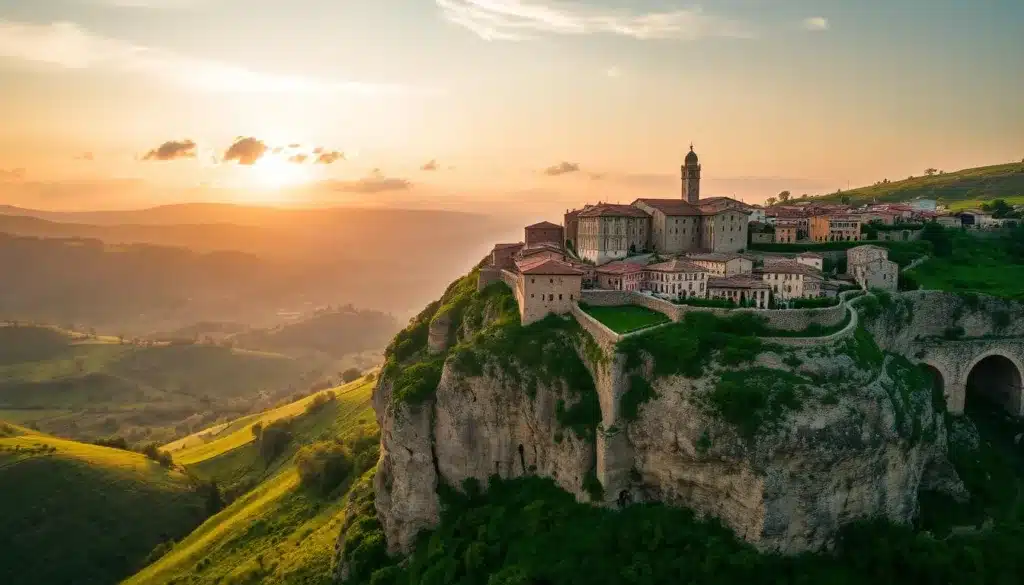
Access and Preservation
To get to Civita di Bagnoregio, you walk 15 minutes on a steep bridge. The village limits visitors to protect it. This helps keep the floating city safe.
Steps to preserve it include:
- Restricted vehicle access to reduce erosion.
- Ongoing stabilization of the tufa rock cliffs.
- Entry fees reinvested in conservation projects.
Best Times to Visit
Visit in spring (April-June) or autumn (September-October) for fewer crowds and nice weather. Winters are quiet but cold. Summers are busier.
Early mornings or weekdays are best for a peaceful visit. You can explore its cobblestone lanes without the rush.
| Season | Pros | Cons |
|---|---|---|
| Spring | Wildflowers, mild temps | Occasional rain |
| Summer | Long daylight hours | High crowds |
| Autumn | Golden landscapes | Cooler evenings |
| Winter | Peaceful atmosphere | Limited amenities |
Walking its ancient arches or watching the sunset, Civita di Bagnoregio is a place where time stops.
Conclusion: Planning Your Italian Village Adventure
Exploring Italy’s villages is a mix of history, culture, and stunning views. Places like Positano and San Gimignano have their own stories. Start by choosing areas like Tuscany, the Amalfi Coast, or Cinque Terre for iconic spots.
For a smooth trip, visit in spring or fall to miss the crowds. Use Trenitalia trains for cheap travel to small towns. Book your stay early in places like Lake Como or Matera. Rent a car to find hidden spots like Castellucio with its wildflowers.
Wear comfy shoes for the cobblestone streets and trails like Vernazza’s Sentiero Azzurro. Use apps like Google Maps or Michelin Guide for local food. Join village festivals, like Pitigliano’s Jewish events, to connect with the culture. Always follow the paths in fragile sites like Civita di Bagnoregio.
Whether it’s the pastel harbor of Corricella or truffle pasta in Orvieto, be spontaneous. Mix planned trips with time to relax in piazzas and enjoy sunsets. With good planning, your Italian village adventure will be unforgettable.

